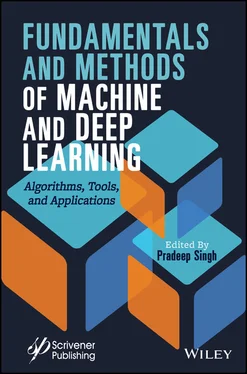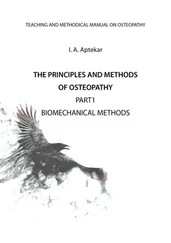Pradeep Singh - Fundamentals and Methods of Machine and Deep Learning
Здесь есть возможность читать онлайн «Pradeep Singh - Fundamentals and Methods of Machine and Deep Learning» — ознакомительный отрывок электронной книги совершенно бесплатно, а после прочтения отрывка купить полную версию. В некоторых случаях можно слушать аудио, скачать через торрент в формате fb2 и присутствует краткое содержание. Жанр: unrecognised, на английском языке. Описание произведения, (предисловие) а так же отзывы посетителей доступны на портале библиотеки ЛибКат.
- Название:Fundamentals and Methods of Machine and Deep Learning
- Автор:
- Жанр:
- Год:неизвестен
- ISBN:нет данных
- Рейтинг книги:5 / 5. Голосов: 1
-
Избранное:Добавить в избранное
- Отзывы:
-
Ваша оценка:
- 100
- 1
- 2
- 3
- 4
- 5
Fundamentals and Methods of Machine and Deep Learning: краткое содержание, описание и аннотация
Предлагаем к чтению аннотацию, описание, краткое содержание или предисловие (зависит от того, что написал сам автор книги «Fundamentals and Methods of Machine and Deep Learning»). Если вы не нашли необходимую информацию о книге — напишите в комментариях, мы постараемся отыскать её.
The book provides a practical approach by explaining the concepts of machine learning and deep learning algorithms, evaluation of methodology advances, and algorithm demonstrations with applications.
Audience
Fundamentals and Methods of Machine and Deep Learning — читать онлайн ознакомительный отрывок
Ниже представлен текст книги, разбитый по страницам. Система сохранения места последней прочитанной страницы, позволяет с удобством читать онлайн бесплатно книгу «Fundamentals and Methods of Machine and Deep Learning», без необходимости каждый раз заново искать на чём Вы остановились. Поставьте закладку, и сможете в любой момент перейти на страницу, на которой закончили чтение.
Интервал:
Закладка:
Library of Congress Cataloging-in-Publication Data
ISBN 978-1-119-82125-0
Cover image: Pixabay.Com
Cover design by Russell Richardson
Set in size of 11pt and Minion Pro by Manila Typesetting Company, Makati, Philippines
Printed in the USA
10 9 8 7 6 5 4 3 2 1
Preface
Over the past two decades, the field of machine learning and its subfield deep learning have played a main role in software applications development. Also, in recent research studies, they are regarded as one of the disruptive technologies that will transform our future life, business and the global economy. The recent explosion of digital data in a wide variety of domains, including science, engineering, internet of things, biomedical, healthcare and many business sectors, has declared the era of big data, which cannot be analyzed by classical statistics but by the more modern, robust machine learning and deep learning techniques. Since machine learning learns from data rather than by programming hard-coded decision rules, an attempt is being made to use machine learning to make computers that are able to solve problems like human experts in the field.
The goal of this book is to present a practical approach by explaining the concepts of machine learning and deep learning algorithms with applications. Supervised machine learning algorithms, ensemble machine learning algorithms, feature selection, deep learning techniques, and their applications are discussed. Also included in the eighteen chapters is unique information which provides a clear understanding of concepts by using algorithms and case studies illustrated with applications of machine learning and deep learning in different domains, including disease prediction, software defect prediction, online television analysis, medical image processing, etc. Each of the chapters briefly described below provides both a chosen approach and its implementation.
Chapter 1assists in learning supervised machine learning algorithms and their applications.
Chapter 2discusses the detection of zonotic diseases using ensemble machine learning algorithms.
Chapter 3provides machine learning model evaluation techniques.
Chapter 4analyzes MSEIR and LSTM models for the prediction of COVID-19 using RMSLE.
Chapter 5discusses the significance of feature selection techniques in machine learning.
Chapter 6provides insight into the development of disease prediction systems using machine learning and deep learning.
Chapter 7discusses the detection of diabetic retinopathy using ensemble learning techniques.
Chapter 8presents a case study for medical analysis of heart disease using machine learning and deep learning.
Chapter 9discusses a novel convolutional neural network model to predict software defects.
Chapter 10familiarizes the reader with the process of predictive analysis on online television videos using machine learning algorithms.
Chapter 11discusses a combinational deep learning approach to visually evoked EEG-based image classification.
Chapter 12gives a comparative analysis of machine learning algorithms with balancing techniques for credit card fraud detection.
Chapter 13describes crack detection in civil structures using deep learning.
Chapter 14discusses measuring urban sprawl using machine learning.
Chapter 15is all about the applications of deep learning algorithms in medical image processing.
Chapter 16assists in understanding the simulation of self-driving cars based on deep learning.
Chapter 17discusses assistive technologies for visual hearing and speech impairments using machine learning and deep learning solutions.
Chapter 18provides insight into the role of deep learning in remote sensing.
Finally, I would like to express my heartfelt thanks to all authors, reviewers, and the team at Scrivener Publishing for their kind co-operation extended during the various stages of processing this book.
Pradeep SinghNovember 2021
1
Supervised Machine Learning: Algorithms and Applications
Shruthi H. Shetty*, Sumiksha Shetty†, Chandra Singh‡ and Ashwath Rao§
Department of ECE, Sahyadri College of Engineering & Management, Adyar, India
Abstract
The fundamental goal of machine learning (ML) is to inculcate computers to use data or former practice to resolve a specified problem. Artificial intelligence has given us incredible web search, self-driving vehicles, practical speech affirmation, and a massively better cognizance of human genetic data. An exact range of effective programs of ML already exist, which comprises classifiers to swot e-mail messages to study that allows distinguishing between unsolicited mail and non-spam messages. ML can be implemented as class analysis over supervised, unsupervised, and reinforcement learning. Supervised ML (SML) is the subordinate branch of ML and habitually counts on a domain skilled expert who “teaches” the learning scheme with required supervision. It also generates a task that maps inputs to chosen outputs. SML is genuinely normal in characterization issues since the aim is to get the computer, familiar with created descriptive framework. The data annotation is termed as a training set and the testing set as unannotated data. When annotations are discrete in the value, they are called class labels and continuous numerical annotations as continuous target values. The objective of SML is to form a compact prototype of the distribution of class labels in terms of predictor types. The resultant classifier is then used to designate class labels to the testing sets where the estimations of the predictor types are known, yet the values of the class labels are unidentified. Under certain assumptions, the larger the size of the training set, the better the expectations on the test set. This motivates the requirement for numerous area specialists or even different non-specialists giving names to preparing the framework. SML problems are grouped into classification and regression. In Classification the result has discrete value and the aim is to predict the discrete values fitting to a specific class. Regression is acquired from the Labeled Datasets and continuous-valued result are predicted for the latest data which is given to the algorithm. When choosing an SML algorithm, the heterogeneity, precision, excess, and linearity of the information ought to be examined before selecting an algorithm. SML is used in a various range of applications such as speech and object recognition, bioinformatics, and spam detection. Recently, advances in SML are being witnessed in solid-state material science for calculating material properties and predicting their structure. This review covers various algorithms and real-world applications of SML. The key advantage of SML is that, once an algorithm swots with data, it can do its task automatically.
Keywords :Supervised machine learning, solid state material science, artificial intelligence, deep learning, linear regression, logistic regression, SVM, decision tree
1.1 History
The historical background of machine learning (ML), in the same way as other artificial intelligence (AI) concepts, started with apparently encouraging works during the 1950s and 1960s, trailed by a significant stretch of accumulation of information known as the “winter of AI” [9]. As of now, there has been an explosive concern essentially in the field related to deep learning. The start of the primary decade of the 21st century ended up being a defining moment throughout the entire existence of ML, and this is clarified by the three simultaneous patterns, which together gave an observable synergetic impact. The first pattern is big data and the second one is the reduction in the expense of equal processing and memory, and the third pattern is acquiring and building up the possibility of perceptron using deep learning algorithms. The investigation of ML has developed from the actions of a modest bunch of engineers investigating whether a machine could figure out how to solve the problem and impersonate the human mind, and a field of insights that generally overlooked computational reviews, to a wide control that has delivered basic measurable computational hypotheses of learning measures.
Читать дальшеИнтервал:
Закладка:
Похожие книги на «Fundamentals and Methods of Machine and Deep Learning»
Представляем Вашему вниманию похожие книги на «Fundamentals and Methods of Machine and Deep Learning» списком для выбора. Мы отобрали схожую по названию и смыслу литературу в надежде предоставить читателям больше вариантов отыскать новые, интересные, ещё непрочитанные произведения.
Обсуждение, отзывы о книге «Fundamentals and Methods of Machine and Deep Learning» и просто собственные мнения читателей. Оставьте ваши комментарии, напишите, что Вы думаете о произведении, его смысле или главных героях. Укажите что конкретно понравилось, а что нет, и почему Вы так считаете.












